Kids Online: 40 Stats about Usage, Benefits, and Risks
Children huddled around playing games together on their iPads, virtual friend requests from new gaming buddies, and kids meeting their friends online for a playdate. These are common scenarios thanks to the internet and modern technologies. From online streaming to social media and gaming, kids have access to a whole different world outside of their families, schools, and communities.
This means parents have extra responsibilities to keep screen time in check and take steps to protect their kids online. In this article, I’ll paint a picture of what children get up to online, how families are managing screen time, and the benefits and risks of being on the internet.
Before that, I’d like to point out that I’ll be using the word parent as a catch-all term for an adult with legal guardianship over a child, to encompass a biological parent, step-parent, foster parent, grandparent, relative, or any other carer responsible for raising a child.
Home Internet and Smartphone Access for Kids
Internet access isn’t a given for every child in this world. This section depicts the current digital landscape, detailing how many households have home internet, smartphone access among children, and the digital inequity between demographics.
#1: Big Gap in Home Internet Access between Rich and Poor Kids
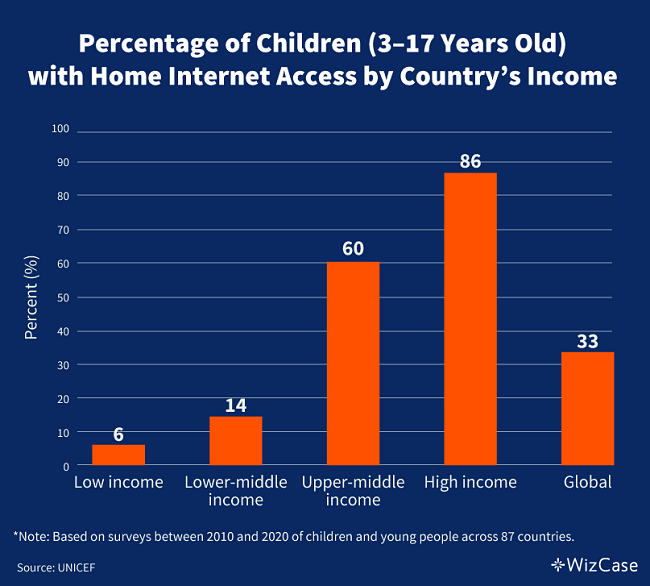
According to a UNICEF report, 67% of school-aged kids — between 3 and 17 years old — are without home internet, with the majority in poor countries. This percentage is more pronounced in the regions of West and Central Africa (95%), East and Southern Africa (88%), South Asia (88%), and the Middle East and North Africa (75%).
This digital divide is also seen among rich and poor households. The global average shows that 57% of school-aged kids in the richest households have home internet, while only 15% of kids in the poorest households have the same luxury.
Having home internet presents more learning opportunities for a child, and this benefit was more pronounced during pandemic-induced lockdowns when classes were held online. Given that schooling years are foundational in a person’s development, this gap must be addressed, especially as a country’s human capital is a vital ingredient in its economy.
#2: Rural Kids Have Less Access to Home Internet Compared to Urban Kids
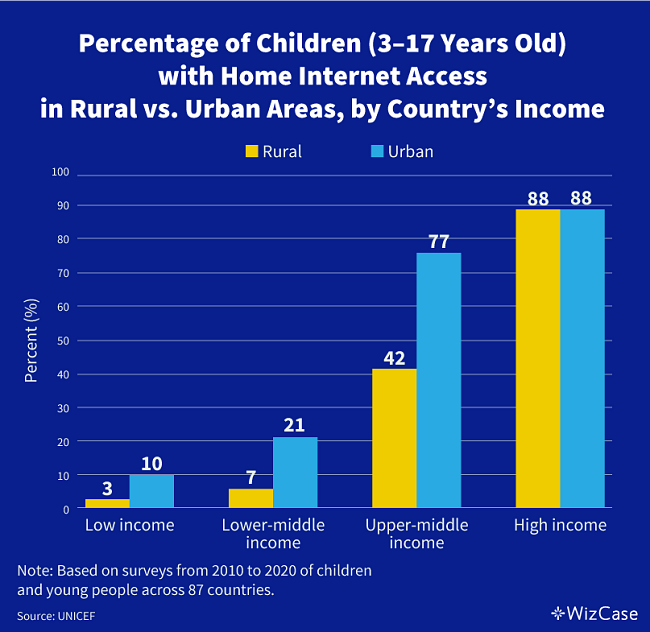
It’s not just household income that determines a child’s opportunities; it’s also where they live. Rural kids are left behind compared to urban kids regarding home internet access.
Although this gap doesn’t exist in high-income countries, it is prevalent elsewhere. In low-income countries, 3% of school-age children have home internet compared to 10% of those living in urban areas, a difference of 7 percentage points. In lower-middle income countries, this gap is wider, with a 14-percentage point difference. The rural-urban divide is most pronounced in upper-middle income countries, with a 35-percentage point difference.
#3: Majority of US Kids Have Internet Access at Home
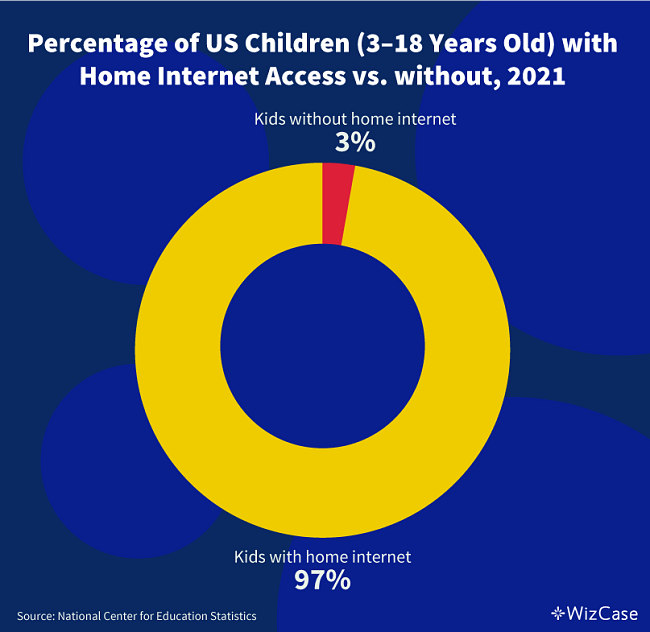
In US households, one factor that increases the likelihood of a child having home internet is the education level of their parents or caretakers.
The highest home internet penetration was among households where parents had a bachelor’s degree or higher, at 98%. This percentage decreases as the parents’ highest educational qualification decreases. 86% of kids with parents who only graduated high school had home internet, while 78% of those whose parents didn’t graduate high school had home internet.
In regards to ethnicity, Asian households registered the highest percentage of home internet at 99%. This is followed by 98% for households with 2 or more ethnicities, 97% for white, Hispanic, and Pacific Islander households, 96% for black households, and 89% for Native American households.
#4: Households without Home Internet Cited Disinterest and Cost as Reasons
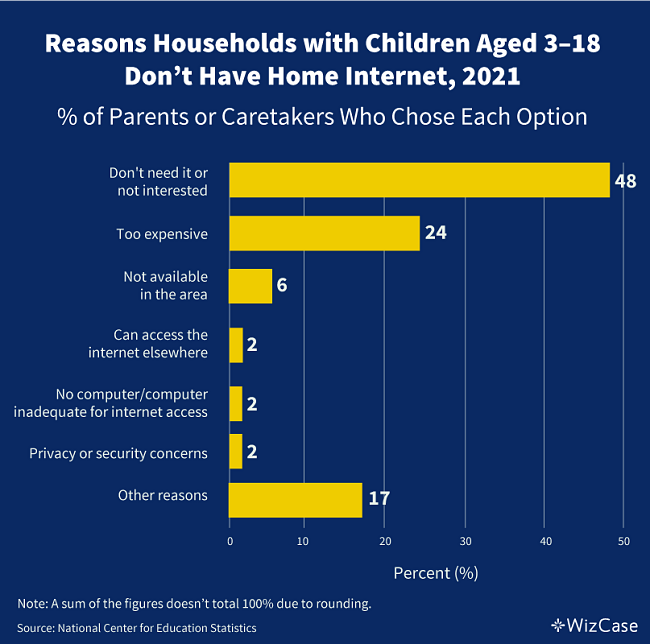
For children whose parents cited cost as a prohibitive factor, they are more likely to come from a mixed-race or black household. Their parents are also more likely to earn less than $40,000 annually and have an education level lower than a bachelor’s degree.
In Europe, the average percentage of kids without home internet or a computer is 5.4%, slightly higher than the US’s percentage of 3%. However, this percentage varies from country to country. For example, less than 1% of children are digitally deprived in Iceland, but over 23% are in Romania.
#5: Native American Kids Living on Tribal Lands Are Left Behind
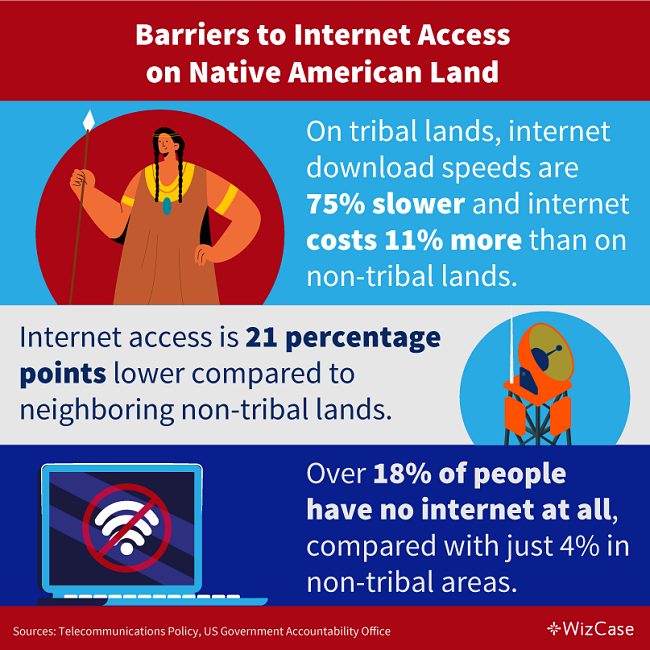
Families living on tribal lands are falling behind in the digital economy. One study found that the broadband access gap between tribal and non-tribal lands is about four times larger than the urban and rural gap.
One of the reasons for this is the high cost of building the broadband infrastructure, as some of the tribal lands are in landlocked, mountainous regions. This makes it unviable commercially for telco companies, given the low population density in those areas. However, the research states that most of the digital divide between tribal and non-tribal lands is unexplained.
Underserved communities without high-speed internet are more likely to suffer from poor health. A Rutgers University paper found that several of the counties in Arizona, Utah, North, and South Dakota without broadband access and poor population health also host many Native American lands.
#6: Nearly Every US Teen Has Access to a Smartphone
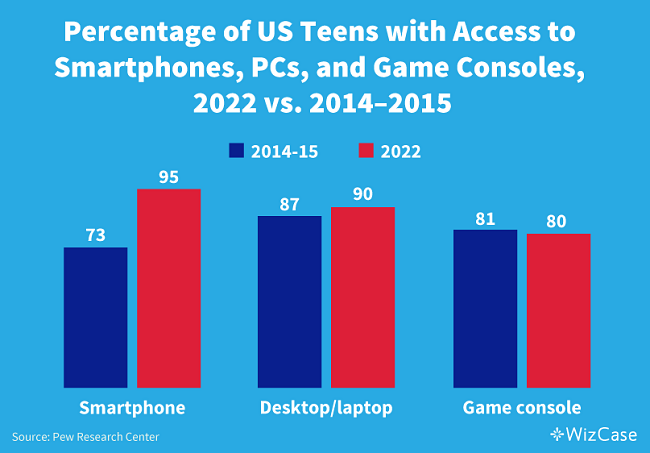
Smartphone usage is increasingly common among US teens, especially older ones. 98% of teens aged 15 to 17 said they own or have access to a smartphone, compared to 91% of those aged 13 to 14.
Household income also plays a factor. Only 93% of teens from households with an annual income below $30,000 can get their hands on smartphones, compared to 96% of those from households earning over $75,000. Black teens are also less likely to access or own a smartphone, with a 5-percentage point gap compared to their White and Hispanic peers.
#7: More than Half of Children Used a Smartphone before 5
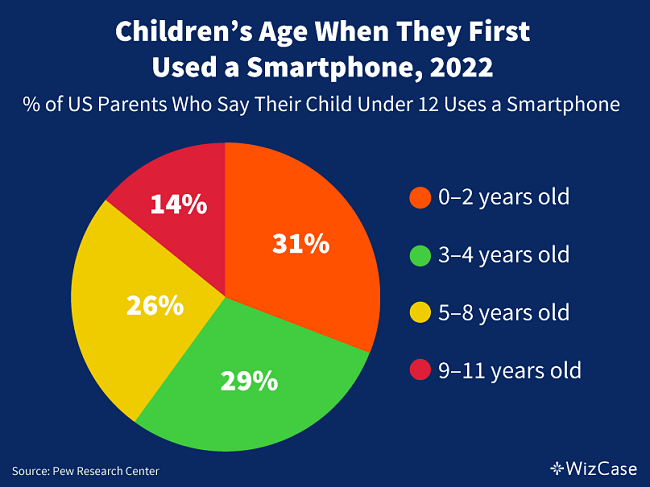
Seeing toddlers with smartphones is becoming increasingly common. A parent survey by the Pew Research Center found that 60% of children under 5 have used or interacted with a smartphone, with half of this percentage using it before the age of 2.
Nearly 1 in 5 parents with a child under 12 had allowed their kid to own a smartphone. Of this number, 51% gave their kids smartphones between the ages of 9 and 11, 35% between the ages of 5 and 8, and the remaining 14% before 5 years old.
What Kids Are Doing Online
This section focuses on the online habits and preferences of preschoolers and school-aged kids. It highlights their primary online activities and the most popular apps for social media, online streaming, online gaming, communication, and education. It also looks at artificial intelligence (AI) usage and online pornography.
#8: Children Spent an Average of 4 Hours Daily on Screens
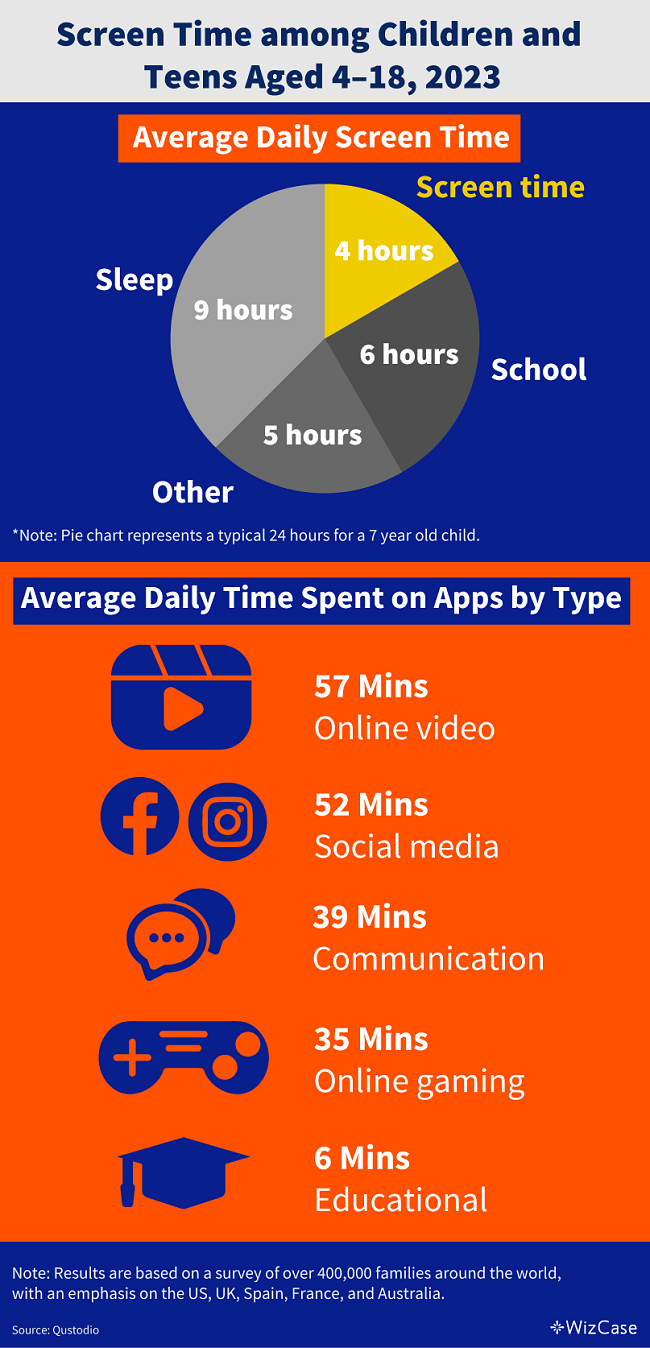
A Qustodio report calculated the global average daily screen time as 4 hours in 2023, the same amount recorded in 2022. This is a substantial amount, considering that children aged 3 to 18 need between 8 and 13 hours of sleep. 4 hours of screen time constitute between 25% and 36% of a child’s waking hours, respectively.
It should be noted that this is an average and not a median figure, which means heavy users of the internet will skew the statistic to be higher. Teenagers are often online more than younger kids. In a Pew Research Center survey, 96% of US teens say they are online daily, with 46% stating they are online nearly all the time.
#9: Social Media Usage among Children at an All-Time High
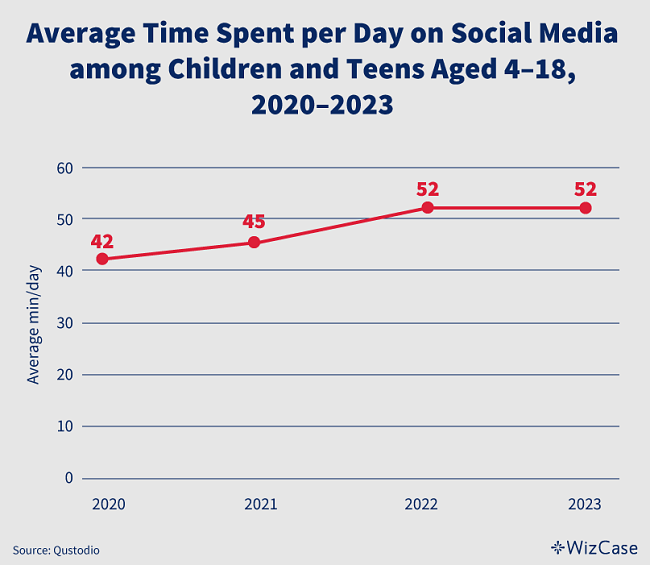
The average time spent on social media has been steadily increasing since 2020, hitting 52 minutes daily in 2023. For Spain, this number is higher at 59 minutes, followed by the UK at 55 minutes, France at 53 minutes, Australia at 51 minutes, and the US at 46 minutes, respectively.
For teenagers, social media is rooted in their lives. According to a Pew Research survey, half of US adolescents found it difficult to give up social media, with girls (58%) finding it harder to forgo social media than boys (49%). When asked about time spent on social media, 55% said they were okay with it, 36% felt they spent too much time on it, and only 8% said they weren’t spending enough time on it.
#10: Teens Love to Post about Their Achievements
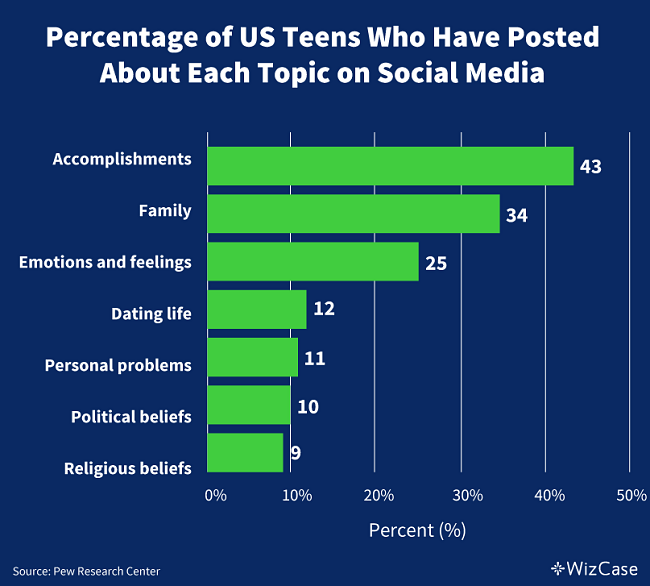
When it comes to what teenagers love to share on social media, nearly half post about their achievements. Only 1 in 10 say they share their personal issues or political and religious views online.
On average, more teen girls aged 15 and over are posting on social media, compared to those aged 13 to 14. This pattern is not seen among teen boys except for achievements and political beliefs. 41% of older teen boys say they have posted about their accomplishments compared to 32% of younger teen boys. Meanwhile, 10% of older boys have shared their political views online, compared to 6% of younger boys.
#11: TikTok Is Still the Top Choice in Social Media
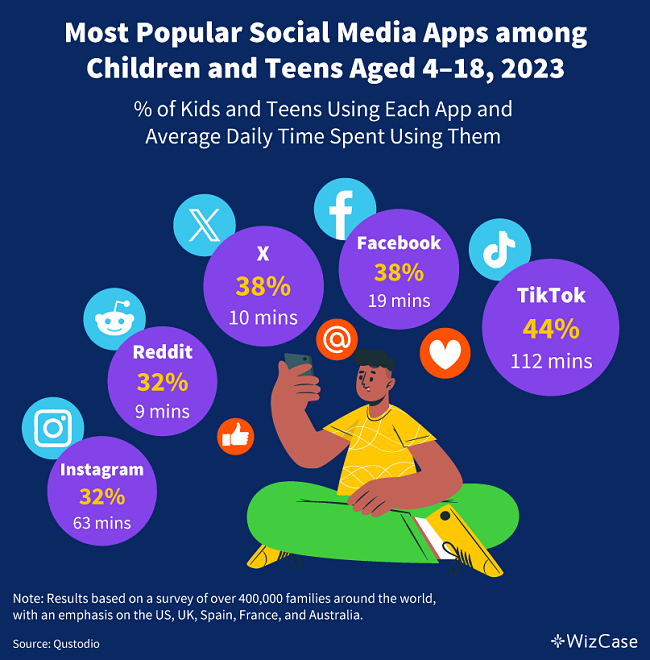
TikTok was the most popular social media platform globally in 2023, and has been since 2020. The global average daily time spent per user was nearly 2 hours in 2023, 23% longer than in 2021. Runner-up Facebook saw its minutes per user fall to an average of 19 minutes daily from 20 minutes the year prior.
Kids are spending more time on TikTok across four of the five main countries covered in the Qustodio report, namely the US, UK, France, and Australia. In Spain, kids spent two minutes less on TikTok on average compared to 2022. For US kids, the average time spent on TikTok rose 6% to 120 minutes from 113 minutes. In a representative survey, nearly two-thirds of US teens say they use TikTok daily, and almost a fifth of them use it “almost constantly.”
#12: YouTube Is the Most Popular Online Video App
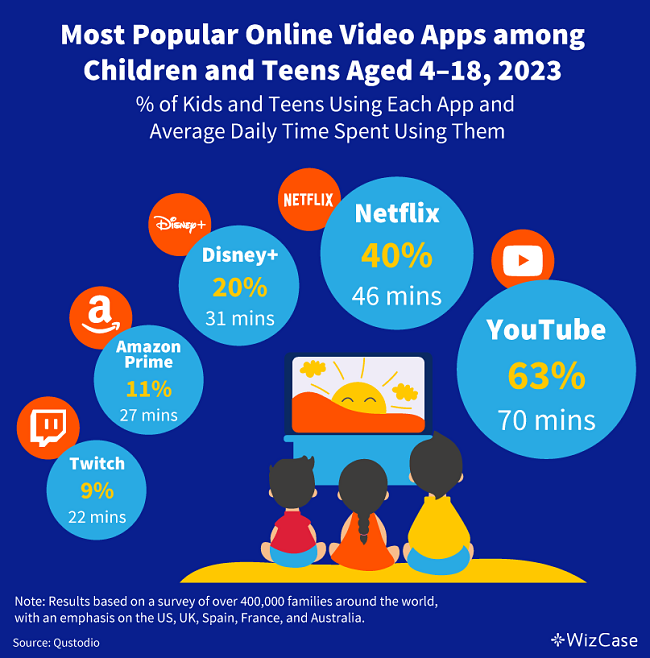
YouTube is the most popular online video app globally, with nearly two-thirds of kids using it, dwarfing other apps. The biggest market for YouTube in a report by Qustodio was Spain, with 71% of kids using the platform. This was followed by France (70%), the UK (66%), the US (60%), and Australia (58%). Time spent on YouTube was also up 4.5% year-on-year, at 70 minutes of average daily time in 2023.
YouTube is also the most popular app for US teens, beating TikTok, when grouping it in the social media category, according to a report by the Pew Research Center. 93% of US teens say they use YouTube, compared to TikTok (63%), Snapchat (60%), Instagram (59%), and Facebook (33%). Nearly 1 in 7 teens say they are constantly on YouTube.
#13: Roblox Is King in the Games Category
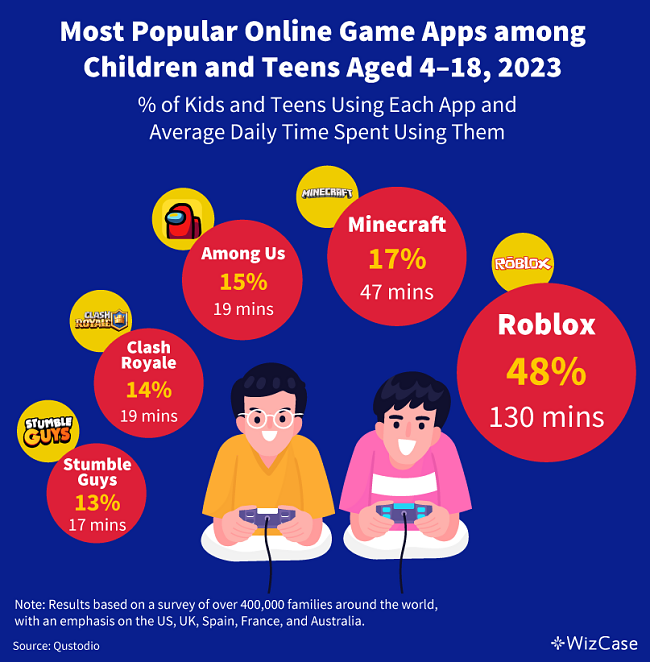
The average time spent playing Roblox is 130 minutes. While this is a significant reduction from 2022’s 180 minutes per day, it still suggests that kids who play this online multiplayer game are heavy users.
Played by nearly half of kids globally, Roblox has been the most popular mobile game since 2019. The report didn’t measure time spent on gaming consoles, PC games, and other devices, suggesting that the time spent on gaming overall could be higher.
Online gaming may come with the temptation of in-app purchases. 31% of parents say they allow it for their kids, with 40% of parents stating they spend less than $10 a month. 15% spend between $50 and $100, and 14% spend between $10 and $20. Overall, over two-thirds of parents are concerned about overspending on mobile games.
#14: WhatsApp Is the Most Popular Communication App
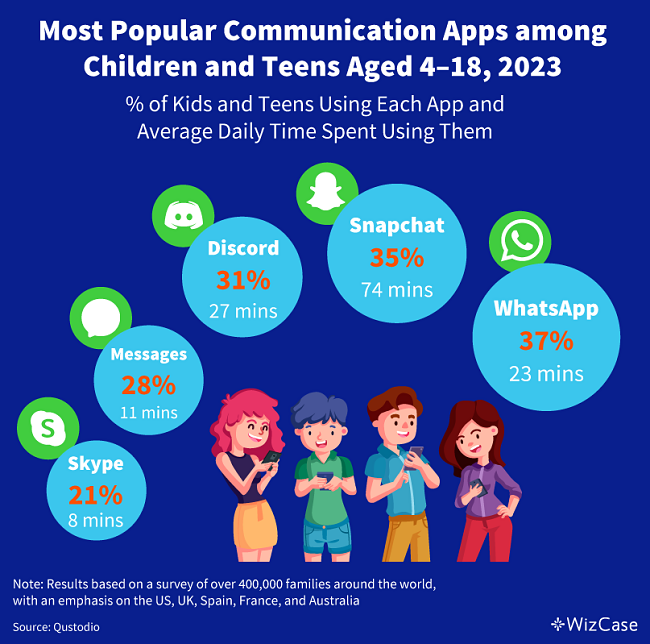
WhatsApp has been the most popular communication app globally since 2019, except in the US and Australia. In the US, WhatsApp is only the sixth most used communications app, being beaten out by Discord, with 33% of kids using it, Snapchat (32%), Messages (25%), Skype (23%), and Google Duo (14%). In Australia, Snapchat (35%) is the most widely used, followed by Discord (34%), Skype (25%), WhatsApp (25%), Messages (24%), and Microsoft Teams (17%).
Globally, kids spent the same amount of time on communication apps in 2023 as in 2022, at 39 minutes per day. Time on Skype fell by 20% over the same period. This seems to be continuing the trend from the previous year, when the use of Skype fell due to the decreased reliance on online communication and fewer virtual classes as countries recovered from COVID-19 lockdowns.
#15: Duolingo Is the Educational App of Choice
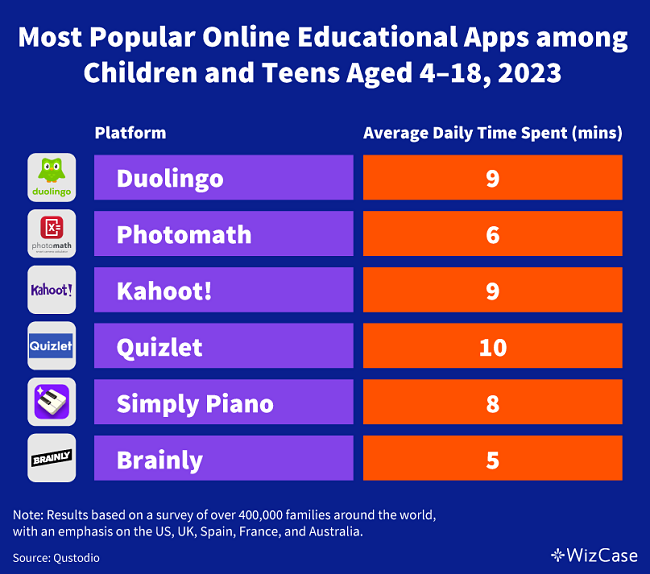
Kids aren’t spending a lot of time on educational apps, with an average daily time of only 6 minutes in 2023, marginally lower than the prior year at 7 minutes.
As more classrooms are using tablets and laptops for lessons, it’s expected that kids aren’t using educational apps as much on their devices. 72% of parents report that their kids use a device at school, with 44% using one provided by the school and 28% bringing in their own devices.
#16: Close to Half of Teens Watch Online Pornography
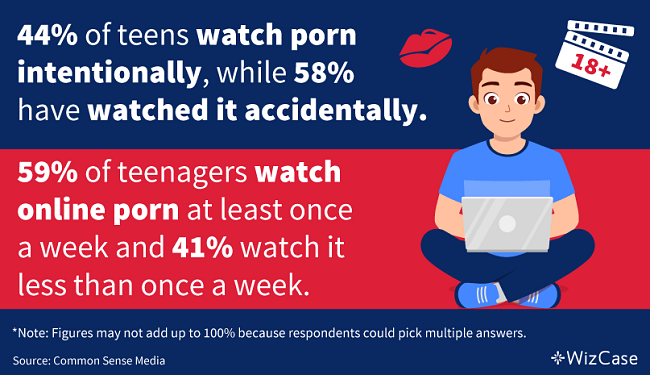
Consumption is higher in boys than girls, with 52% of cis boys watching online porn, compared to 36% of cis girls. The percentage increases among LGBTQ+ teenagers, at 66%. The average age at which teens first watch porn, whether intentionally or accidentally, is 12 years old.
Nearly half of teenagers think online pornography is a form of sex education. While many teens say they have discussed sex-related topics with a trusted adult, only 43% of them touched on pornography. The 51% who did discuss porn with an adult say it was a positive outcome, stating that the discussion encouraged them to explore their sexuality and sex in other ways besides porn.
#17: Kids Are Using Generative AI Too
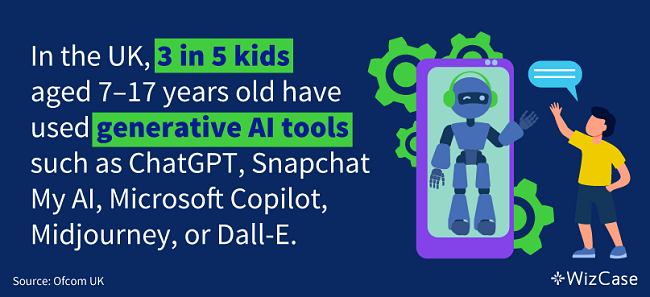
According to the UK’s Ofcom, adolescents are the biggest users of generative AI, with 79% of those aged 13 to 17 using it compared to only 40% of kids under 13. The most popular tool is Snapchat MyAI, possibly because it’s a Snapchat feature and therefore very accessible for kids.
When it comes to schoolwork, 1 in 5 American teenagers have used ChatGPT, with 21% of boys saying so versus 17% of girls. Most teens find using ChatGPT for research acceptable, but only 20% feel it is okay for writing essays. In a YouGov poll, 59% of adults felt that their school-aged kids needed to learn AI in school for future careers.
How Parents Manage Their Kids’ Screen Time
Moderating screen time can be a headache for parents. In this section, I examine parents’ main concerns and opinions regarding screen time, how device usage affects families, and what approaches parents are taking for screen time management.
#18: Parents Say Parenting Nowadays Is Harder Due to Technology
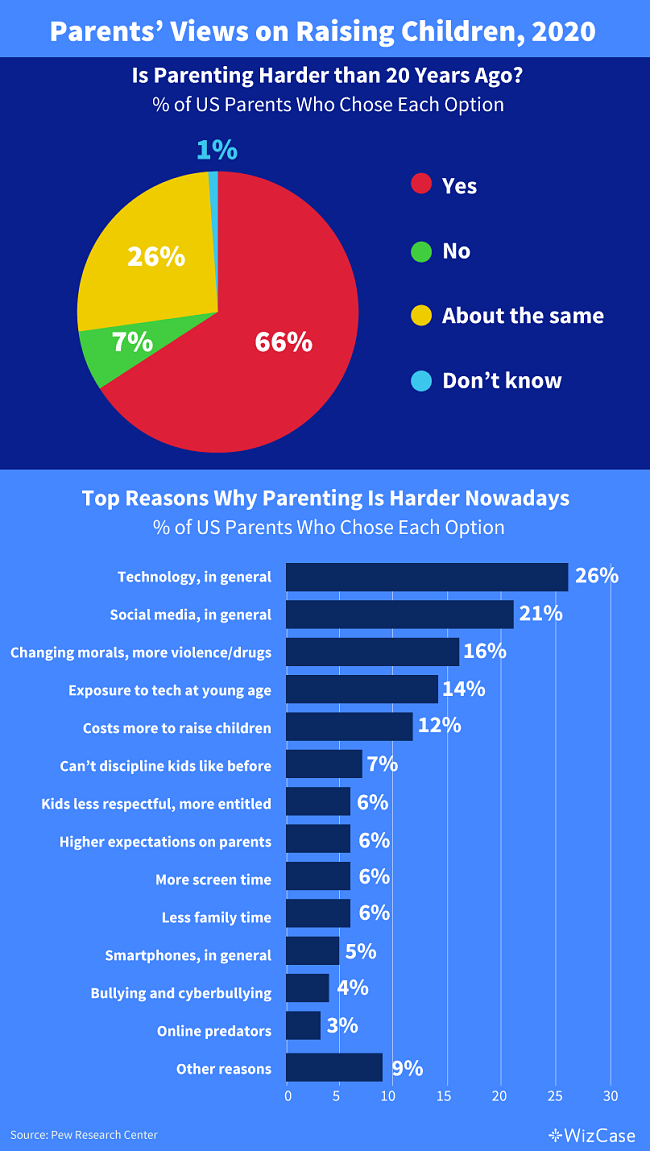
Technology-related concerns dominate the top 5 reasons why parents think raising kids is trickier compared to 20 years ago. Worries over technology and social media rank higher than drug, violence, moral, and cost issues.
The reasons could be related to the fears that parents have over cyberbullying, exposure to online predators, and peer pressure from social media. They may also be concerned about their young children’s exposure to devices. Many parents have to rely on smartphones and tablets to occupy their children at home and may struggle to manage device usage.
#19: Consensus Says 12 Is the Right Age to Start Owning a Smartphone
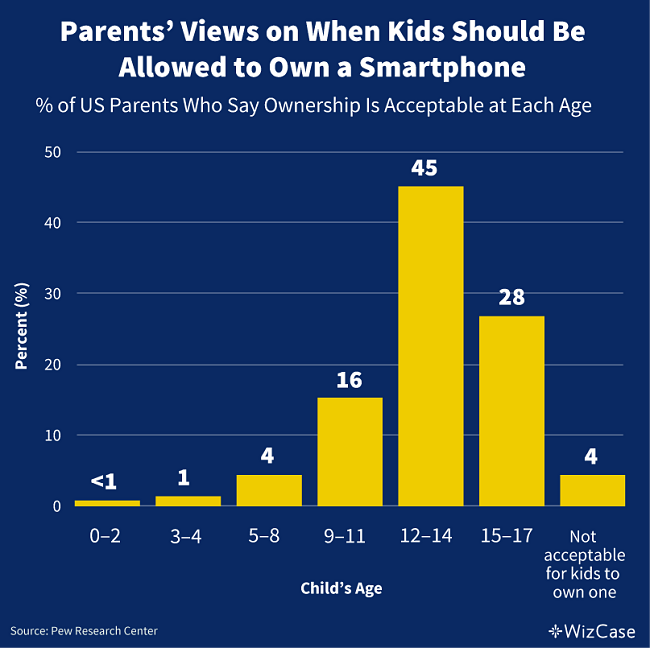
The majority of parents say their biggest concern with giving a child under 11 a smartphone is the impact on their ability to make friends and develop good social skills. Slightly more than half of parents think smartphones would impede their child’s progress at school, while nearly half feel it would hurt children’s creativity. Instead, most parents (65%) are more comfortable giving their kids a tablet instead.
12 years old is also the magic number when it comes to allowing children on social media, with 78% of parents agreeing so. It’s worth noting that TikTok, Facebook, Instagram, and Snapchat require their users to be 13 years and older but lack a mechanism to validate user ages.
#20: Most Parents Are Concerned about the Amount of Screen Time
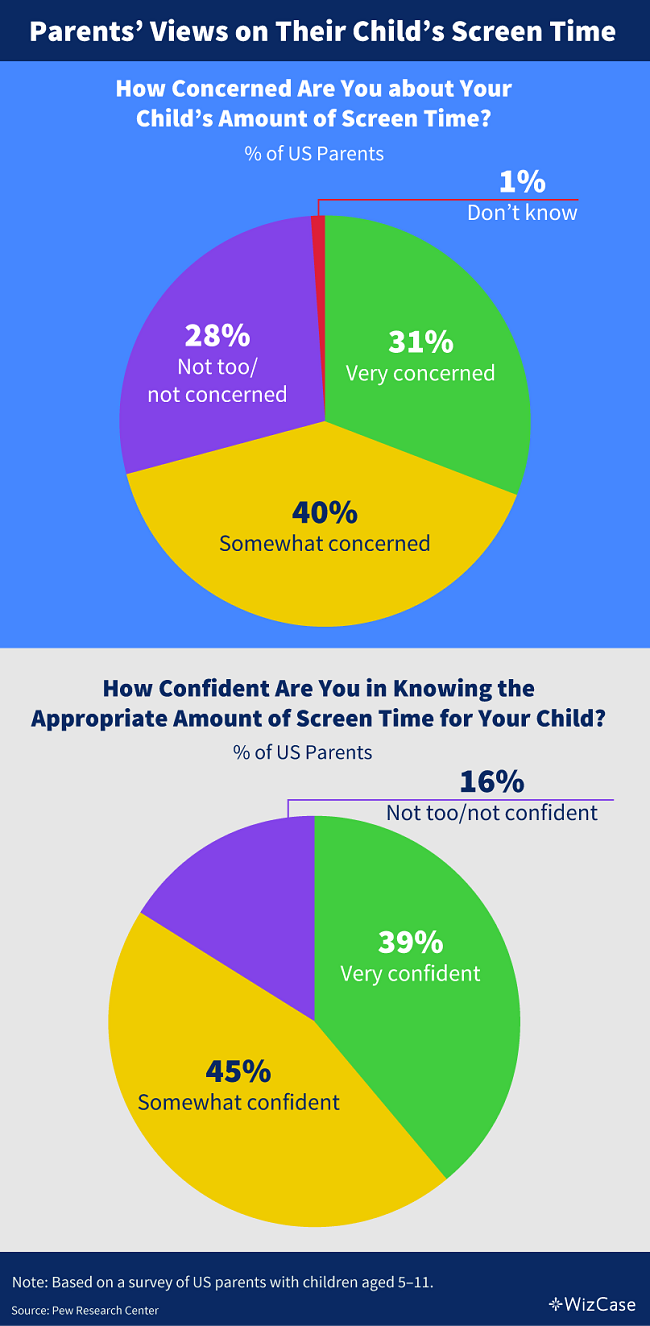
7 in 10 parents with children under 12 are worried about the amount of screen time their kids are getting. Although most parents think they know the appropriate amount of screen time for their kids, they are still seeking guidance from third parties. Over half of parents sought advice from doctors, medical professionals, and other parents. Other sources of information include teachers, parenting sites and blogs, books, social media, and online message boards.
#21: Half of Households Say Screen Time Causes Arguments
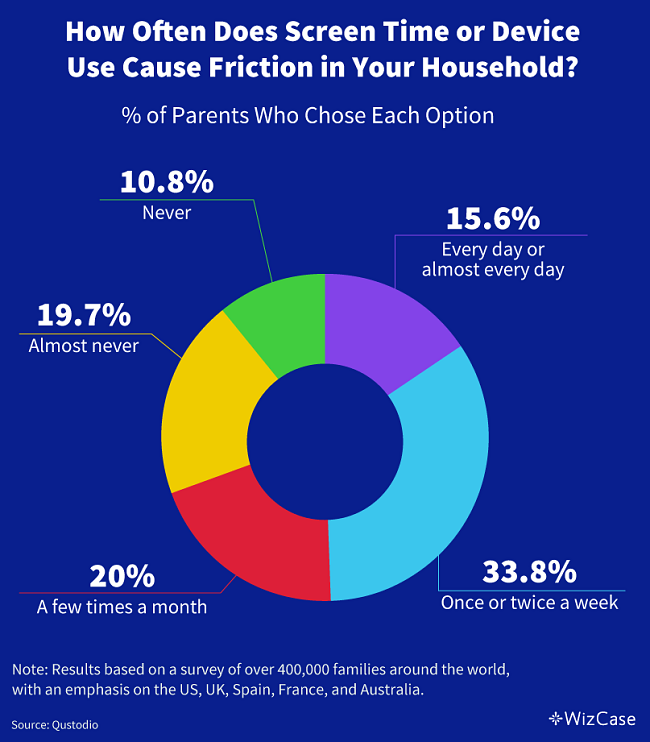
Screen time causes friction every day or a few times a week in nearly half of households, according to a 2023 report. Device usage also takes away quality time with the family for nearly 7 in 10 households.
However, nearly half of parents also feel guilty over their own screen time. Younger parents are more likely to struggle with managing their screen time compared to those who are older. 56% of parents between the ages of 25 to 34 find it hard to stay off screens, compared to just 27% of those between 55 and 65. The majority of parents say they aren’t doing anything to remedy this.
#22: Parents Use Several Methods to Manage Screen Time
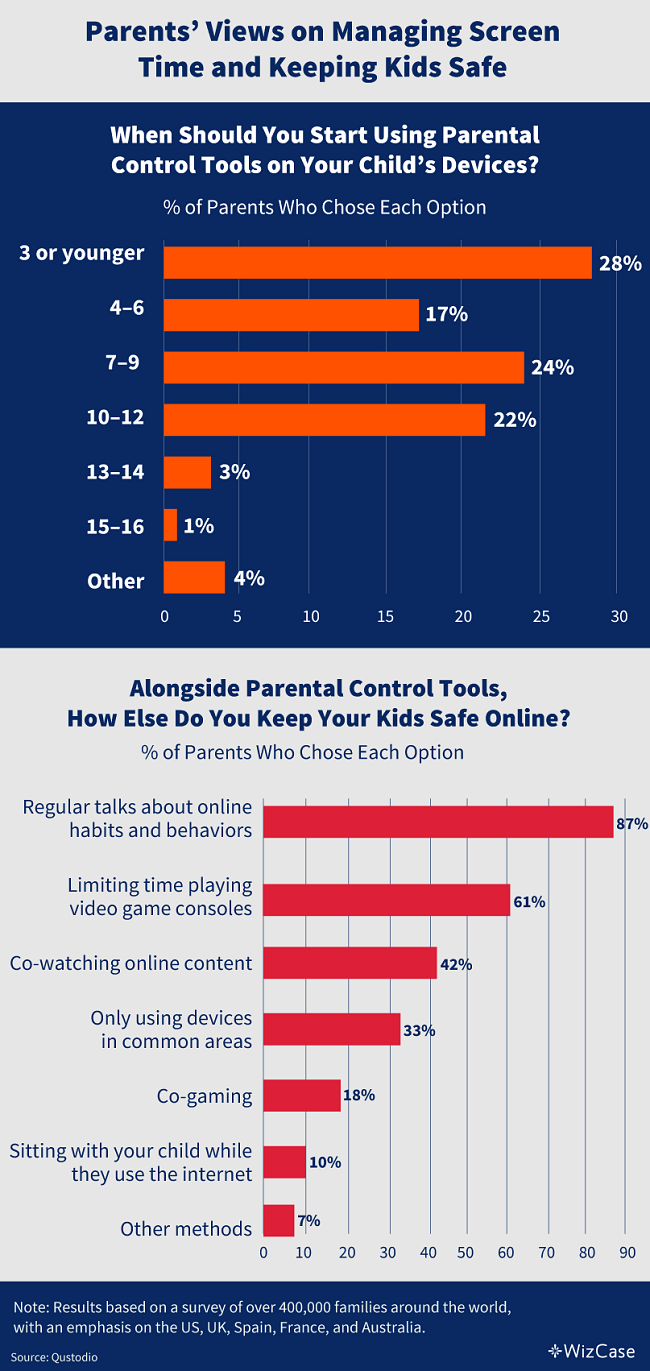
Parents say that the top 3 biggest online risks for their kids are exposure to adult content, being targeted by online predators, and developing an online addiction. As such, parents are using several strategies to monitor and manage screen time with parental control tools being a popular choice. Nearly 70% of parents believe in using these tools before their child is 10.
Using the Internet Brings Many Benefits
The advantages of using the internet are undeniable for children. It offers them the opportunity to learn, explore their interests, express themselves creatively, and connect with like-minded peers while equipping them with the skills needed to thrive in a digital world. You’ll read statistics and research that support the positive effects of the internet on young minds in this section.
#23: Kids Learn and Acquire New Skills
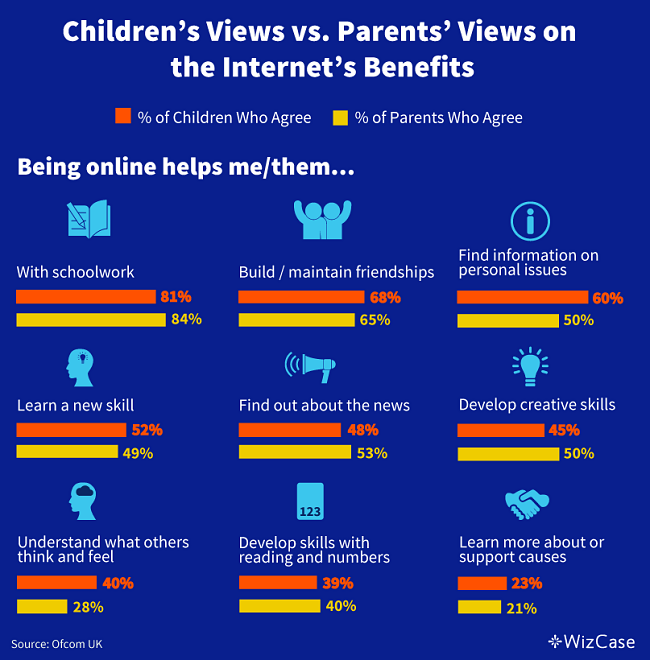
When it comes to the internet’s many benefits, the views of parents and children are mostly aligned in schoolwork, friendships, research, creativity, and skilling up—with one exception, and that is in developing social skills. Only 28% of parents feel the internet helps children understand what others are thinking and feeling, compared to 40% of kids.
#24: Kids Also Gain Essential Digital Skills
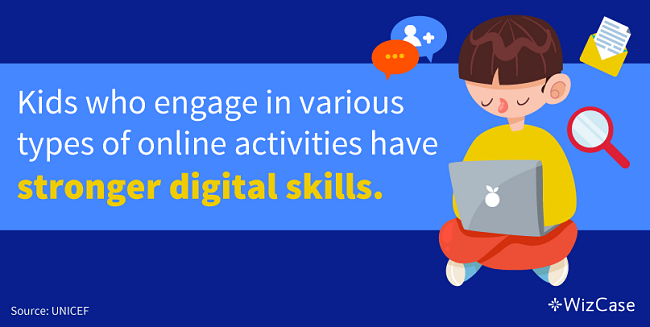
In broad terms, digital skills are about knowing how to research information online, assess and create online content, protect oneself online, communicate and collaborate effectively, and accomplish online tasks that are necessary to survive in today’s digital world. These skills are needed both at work and in schools, as more classrooms now come equipped with laptops and tablets.
According to a UNICEF report, children gain digital skills when online, even when it’s just playing games or watching video clips. A study published in New Media and Society also found a positive link between digital skills and benefits such as discovering online opportunities and affinity for technology, based on a systematic review of 34 studies among those aged 12 to 17.
#25: Social Media Can Help Build Meaningful Connections
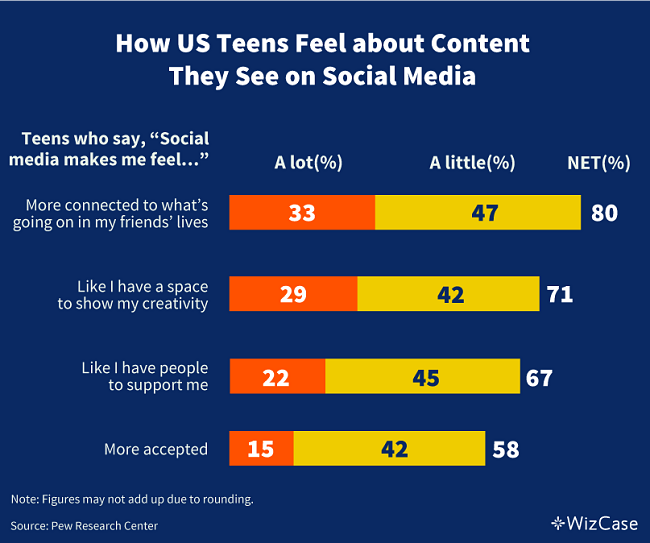
With social media entrenched in a typical teenager’s life, it’s no wonder that most find it a good outlet to make new friends or maintain existing friendships.
Teens seem to think that social media has a worse effect on their peers than on themselves. When asked about the impact of social media personally, only 9% found it mostly negative, 32% found it mostly positive, and the rest said it was neutral. However, when asked about how their peers are affected by social media, 32% felt it to have a mainly negative effect.
#26: Families Spend Quality Time by Watching Streaming Content Together
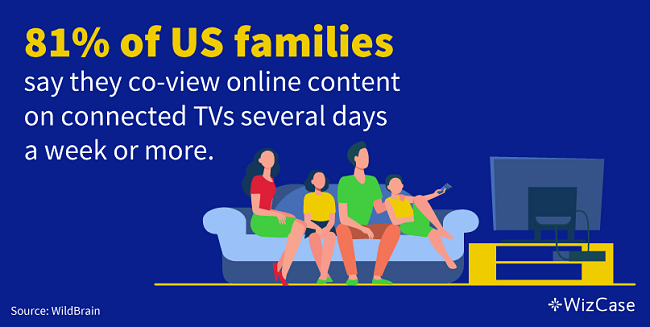
Co-viewing online content is a popular family activity. The majority of parents say the reason they co-view with their kids is ‘to relax’, and 56% view this activity as part of a routine before bedtime. The top 3 favorite genres are comedy (61%), superheroes (48%), and action (42%). Research also supports co-viewing as a beneficial family activity for young children as it helps them understand the content better with guidance from their parents.
#27: Teens Get Motivated to Support a Cause They Believe In
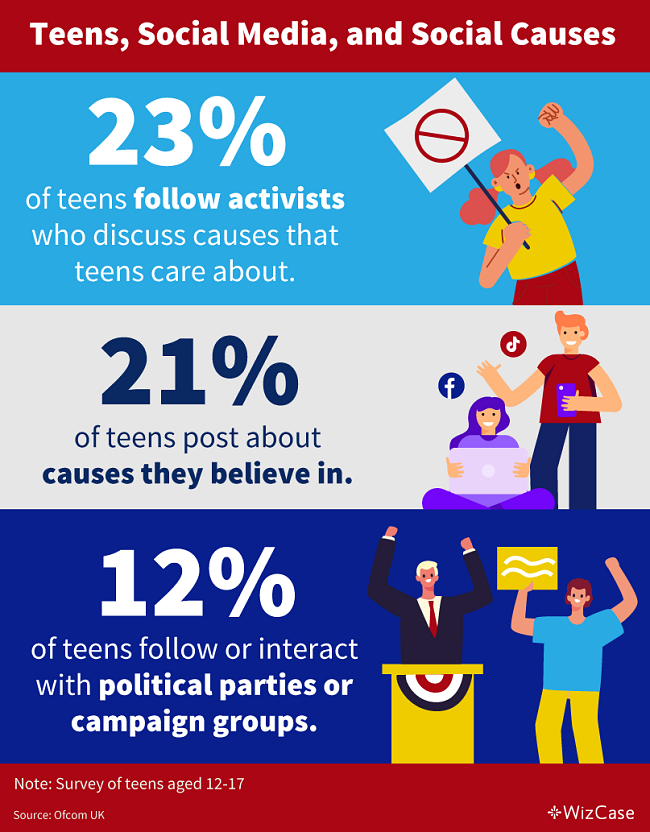
Social media is a channel for teenagers to find social and political issues they feel strongly about. Social media influencers play a strong role in raising awareness for causes, and many teens rally behind a cause from influencers they follow.
Teenage girls are more likely to take up a cause compared to teenage boys. In the age group of 12 to 15 years old, there were almost twice the number of girls (27%) than boys (15%) who follow activists online.
Being Online Exposes Kids to Risks
Children aren’t always safe online. This section outlines the hazards of being online, such as encountering online predators and cyberbullies, falling prey to cybercrimes, and being exposed to content that is harmful to a child’s mental health.
#28: Most Children Have Encountered a Cyber Risk
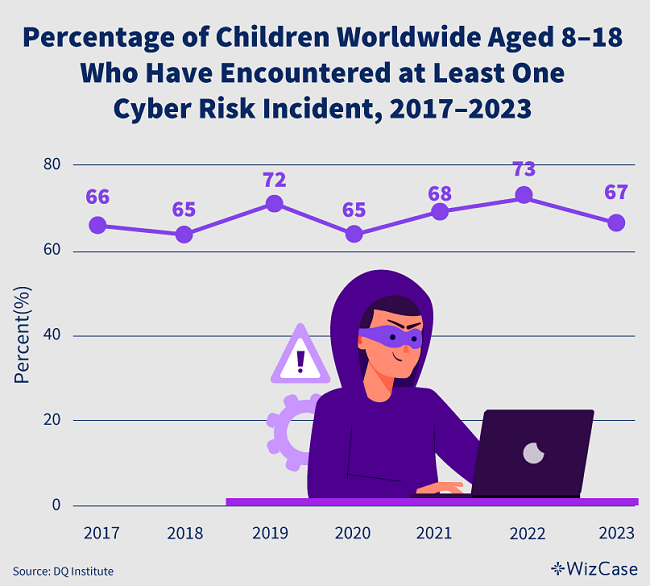
As children spend more time online, they are vulnerable to cyber-risks such as bullying, scams, online grooming, exposure to sexual and violent content, and addiction to online gaming and social media. Around two-thirds of children experienced at least one cyber risk yearly, and this number has remained consistent since 2017, well before the pandemic, when children were online more than usual.
This highlights the urgent need for adults to be made aware of any cyber-risk incidents. However, in a Boston Consulting Group (BCG) survey, only 39% of parents said their children had expressed concerns about online threats. This was notably less than the 72% of children who had been exposed to a cyber threat.
#29: Teens Are Exposed to Cyberbullying
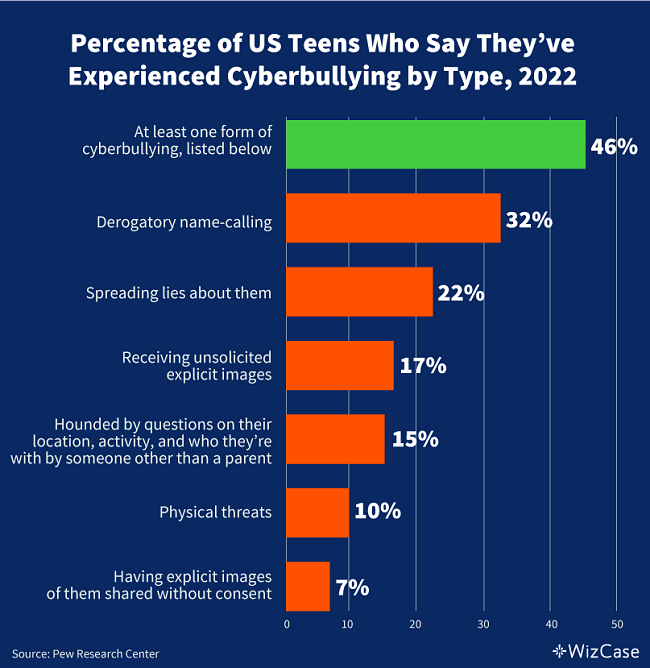
A survey by the Pew Research Center confirms that cyberbullying is a major concern for teenagers, an age at which people are just forming their identity. Nearly half of teens in this representative survey say they have experienced being bullied or harassed online.
When asked why they were being bullied, 15% said they were being targeted for their physical looks, 10% for gender, 9% for race, 5% for sexual orientation, and 5% for political views. Older girls aged 15 to 17 were more likely to be bullied. When it comes to solutions, half believe that banning bullies from social media platforms would alleviate the issue.
#30: Kids Are Susceptible to Online Predators
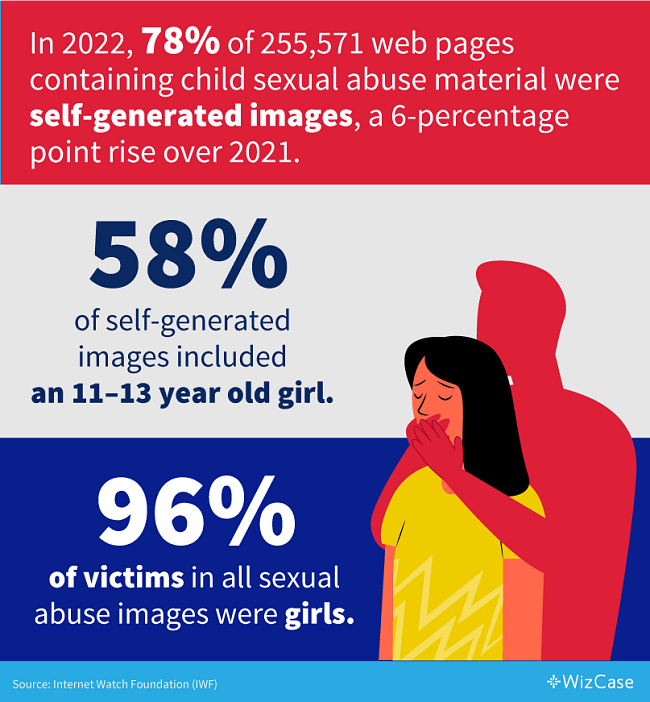
Self-generated sexual content — content that appears to have been made by the person in the video or image — made up the bulk of child sexual abuse materials that were assessed by the non-profit Internet Watch Foundation in 2022. These images are usually taken on smartphones or webcams. Some of these children may have been groomed or even coerced by online predators.
One concerning trend is that younger kids are increasingly vulnerable to and targeted by online predators. The number of abusive images involving a child between 7 and 10 years old increased by 60% year-over-year in 2022. Conversely, cases in the age group of 11 to 13 years old had declined 14% year-over-year.
It’s important to talk to your children, especially teens, about the dangers of online predators and grooming, especially as meeting new people in online games and social media platforms is becoming the norm.
#31: Kids Could Fall Victim to Cybercrimes
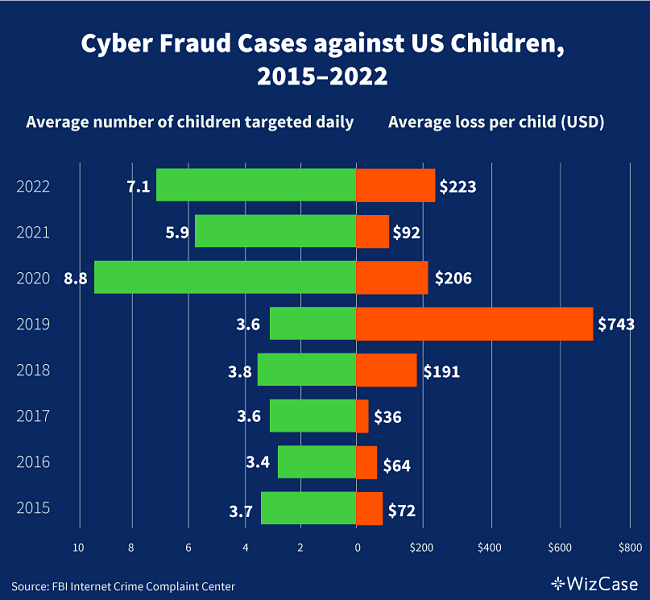
Based on FBI data, cybercrimes against children have been rising since 2020, with more than half of the cases recorded this decade. 2020 saw a record number of victims, with an average of 8.8 children targeted every day. This could stem from the fact that kids were online more often due to pandemic-related lockdowns. Before 2020, the average number of kids targeted daily was consistently lower and never rose above 3.8 children per day.
Meanwhile, 2019 saw the highest record of average financial losses at $743 per victim, more than triple the second-highest number recorded, which was $223 in 2022. Between 2015 and 2022, a total of $2.9 million was lost to cybercrimes, from a total of 14,500 child victims.
#32: Kids Could Be Exposed to Harmful Content
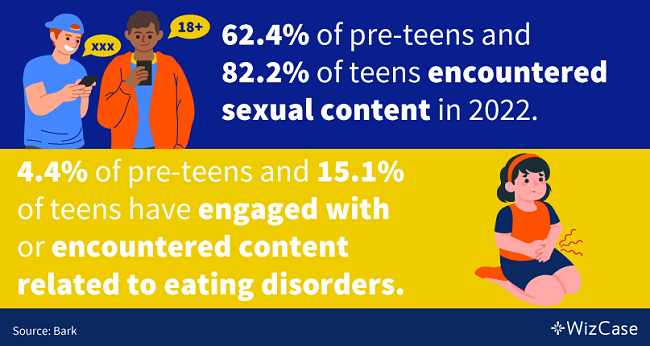
Children could be exposed to harmful content related to sex or eating disorders when online. A report by parental control app Bark flagged the Kik Messenger app as the worst for severe sexual content. Worryingly, 40% of teens say that it’s common for their peers to share nudes, according to a survey by Thorn.
Content related to eating disorders such as anorexia and bulimia is especially harmful during the teenage years, when bodies go through significant changes. Bark flagged Instagram as the worst app for negative body image content.
#33: US, Canada, UK, and China Fare Well in Protecting Kids Online
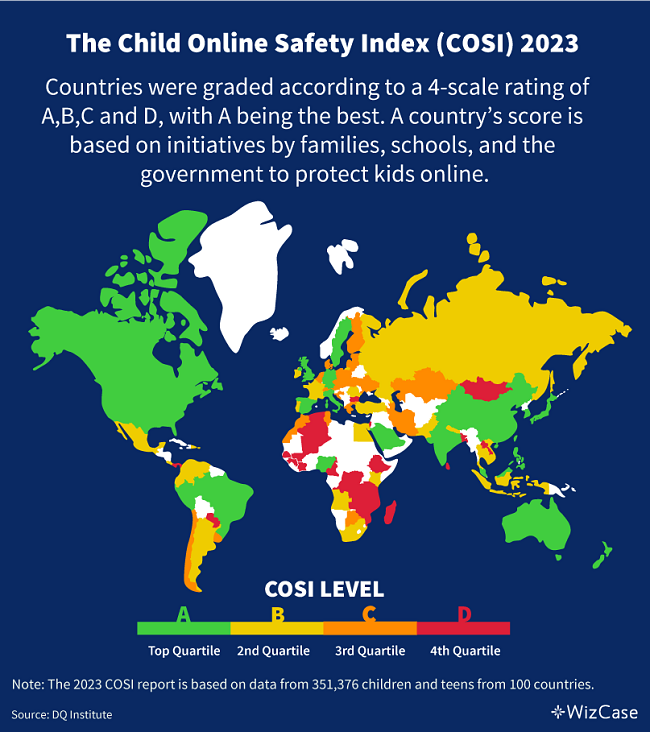
Based on an index by the DQ Institute, middle- to high-income countries such as the US, Canada, Germany, the UK, China, and Japan scored highly in protecting children’s safety online, placing in the top quartile. Meanwhile, many low-income countries, like Malawi, Ethiopia, and the Democratic Republic of Congo, were placed in the bottom quartile.
The Child Online Safety Index (COSI) score looks at the efforts of multiple parties, including families, schools, and governments, in ensuring kids are safe online.
Excessive Screen Time and Internet Addiction
It would be remiss to talk about screen time without considering the effects of excessive use. In this final section, I present data on whether youngsters are spending too much time online, identify parents’ concerns about internet addiction, and reveal the alarming consequences when screen time goes overboard.
#34: Fewer than Half of Kids under 5 Meet Screen Time Guidelines
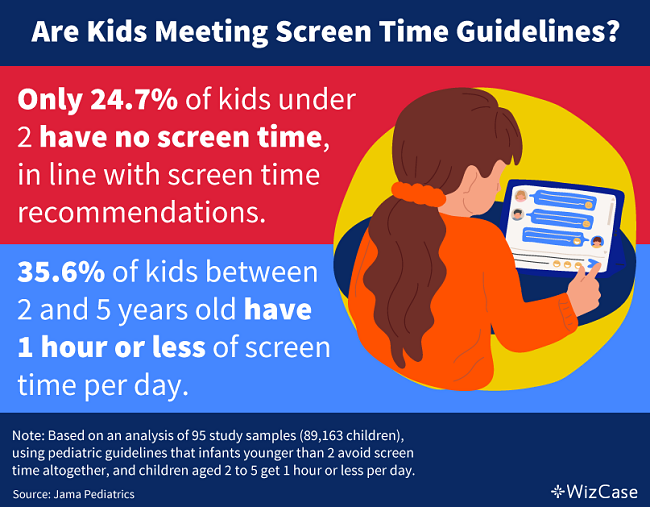
Only a minority of toddlers and preschoolers meet recommended screen time guidelines. While this finding is alarming, the study did find that more children younger than 5 are sticking within the recommended limit, suggesting that awareness among parents has improved in recent years.
There are varying recommendations on screen time for kids under 5. Some amount of high-quality, educational content may be good. But the consensus for content that is purely for entertainment is the less, the better. Children benefit most from face-to-face interaction with adults to help them learn. If using a screen, an adult should be interacting with their kids and the content, instead of leaving them sitting in front of a TV or tablet alone.
Numerous studies have shown a link between increased screen time and developmental issues. In one study, researchers found that children who had more than an hour a day of screen time at 1 year old had a higher risk of having developmental delays in communication, fine motor, social, and problem-solving skills at age 2. At age 4, they were more likely to be behind in communication and problem-solving skills.
#35: The Number of Teens Who Are Always Online Has Doubled
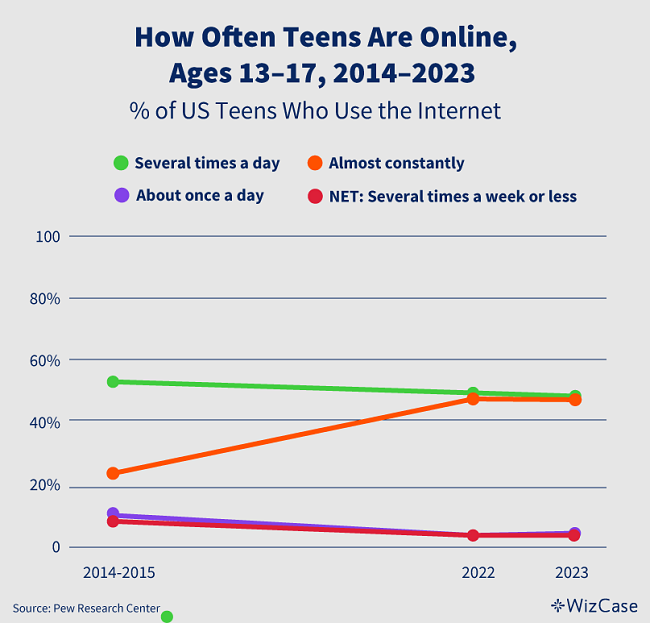
Teenagers are increasingly spending their time on the internet with 46% online constantly, double the percentage recorded between 2014 and 2015.
Of this cohort, Hispanic (55%) and black (54%) ethnicities tend to be the heaviest users, followed by white (38%). Teens 15 years old and up are also more likely to be always connected (50%) compared to those who are younger (40%). And finally, 54% of teens who come from households with an annual income below $30,000 say they are always online, compared to 45% of teens in households earning above $30,000.
#36: Parents Are Concerned about Internet Addiction
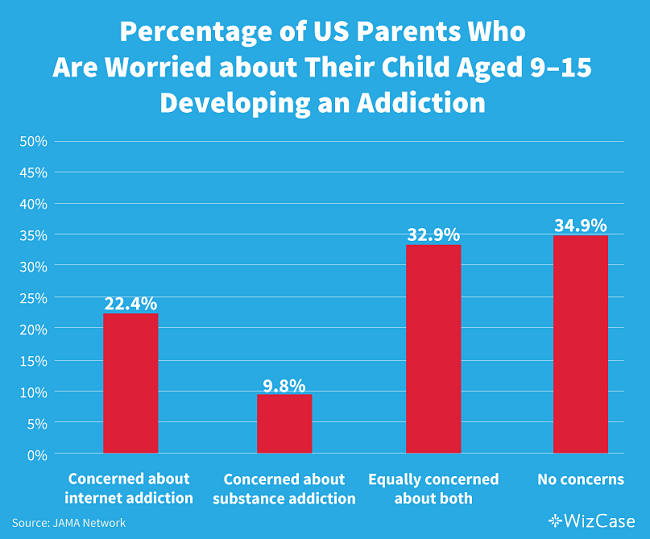
Concerns over internet addiction weigh heavily on parents’ minds, outweighing drug and alcohol worries. In a study, 22% of parents say they are worried about their children getting addicted to the internet, double the number who say they are concerned about substance addiction. However, parents also understand the benefits brought by the internet, such as allowing families to stay connected.
Currently, internet addiction is not classified as a mental health disorder under the latest edition of the Diagnostic and Statistical Manual of Mental Disorders (DSM-5), but another kind of addiction is — internet gaming disorder (IGD).
IGD is defined as when online gaming causes significant impairment and distress to an individual’s life, leading to withdrawal symptoms, an inability to stop, and using manipulation to keep the habit. The global prevalence of IGD is estimated at roughly 3%, and the prevalence rate tends to be higher among adolescents.
#37: Increased Screen Time Contributes to a Sedentary Lifestyle
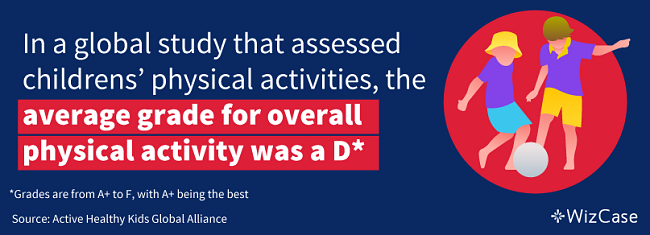
Children are not getting enough exercise, and screen time is one of the reasons.
According to the World Health Organization (WHO), kids between the ages of 5 and 17 need at least one hour of moderate to vigorous physical activity every day. They also need to limit the number of sedentary activities, especially recreational screen time.
In a study covering 57 countries, only 27% to 33% of kids in this age group are doing enough physical activity. In the US, a separate study found that only 8.8% of children are meeting all the recommendations on physical activity, sleep, and screen time. While the majority (86%) are getting enough sleep, only a fraction meet screen time (33%) and exercise (23%) recommendations.
#38: Screen Usage Could Affect Quality of Sleep
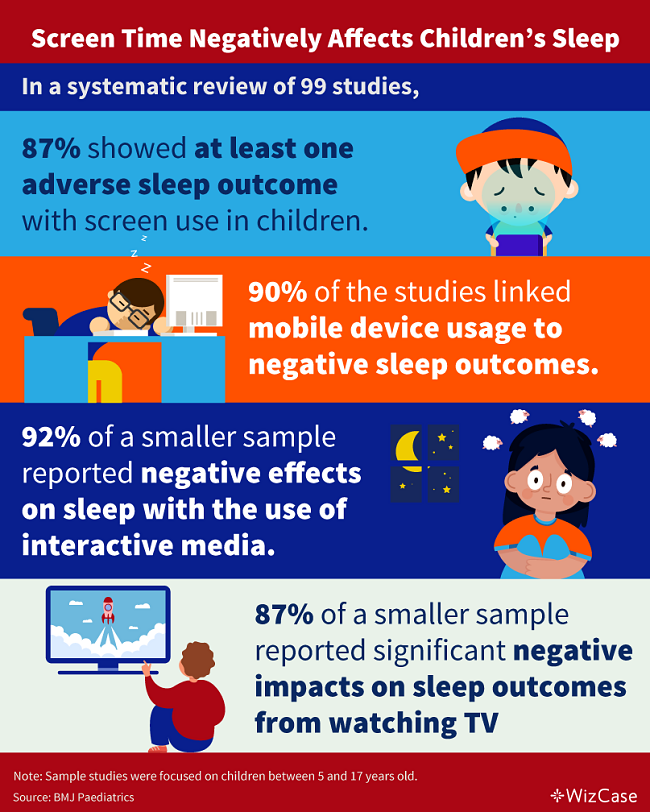
Good sleep is vital during the growing years, and any screen time near bedtime is generally a bad idea.
In a systematic review of 99 studies on the effects of screen time on sleep quality, the majority reported a negative sleep outcome. A negative sleep outcome includes difficulty falling asleep, shorter sleep duration, poor sleep quality, and daytime sleepiness. Among all screen usage, being on social media and playing video games close to bedtime had the biggest negative effect on sleep duration.
#39: Heavy Phone Usage Increases Odds of Poor Mental Health
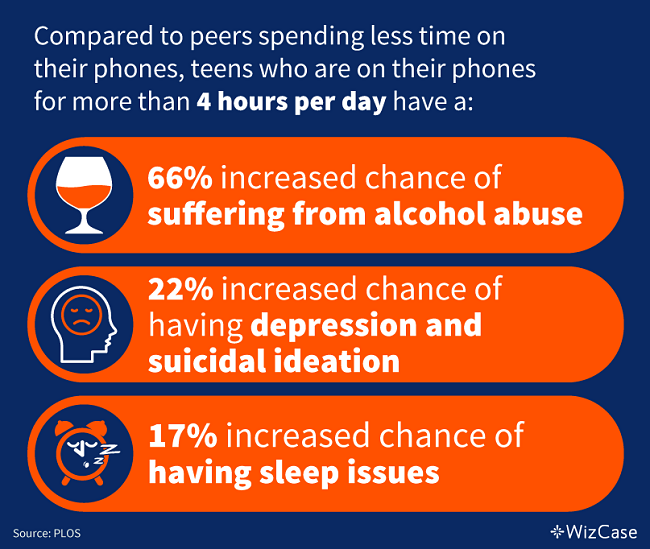
A study of over 40,000 South Korean adolescents found no negative health outcomes (other than over-dependence) from using smartphones for as much as 4 hours per day. However, at the 4-hour mark and above, the odds of having mental health problems increased for teenagers.
Those who spend more than 3 hours a day on social media have also been found to have double the odds of developing issues such as depression and anxiety. Fortunately, there seems to be a way to prevent or lessen these problems associated with heavy social media usage. A separate study showed that when a teenager reports having a strong and loving connection with their parents, the chances of developing mental health problems are lower.
#40: US States Are Trying to Hold Social Media Companies Accountable

Based on a report by the Centers for Disease Control and Prevention (CDC), there is a mental health crisis among American youths. In 2021, 42% of US high schoolers experienced a persistent feeling of sadness and hopelessness, a half-fold increase from 28% a decade prior. 22% had seriously contemplated suicide, up from 16% in 2011.
Amid this crisis, lawmakers are putting some of the blame on social media companies. Meta, the parent company of Facebook and Instagram, is facing multiple lawsuits consisting of a joint filing in federal court from 33 states, as well as lawsuits from 8 individual states and the District of Columbia in various other courts. The details of each lawsuit vary, but the main contention is that Meta is knowingly and directly contributing to the mental health crisis among teens.
An investigation by the Wall Street Journal found that the social media behemoth ignored its own research that showed Instagram was causing poor mental health outcomes for teens, especially girls. Furthermore, Facebook and Instagram are designed to keep users on them for long periods, without any regard for the consequences for young children who may show addictive behaviors associated with these platforms.
Other corporations are also feeling the heat. YouTube announced in late 2023 that it would limit recommending videos that are related to aggression and body image to its youth audience amid multiple criticisms.
The Bottom Line
The internet is influencing a generation of children. Kids first experience the internet at a young age, and most teens use it daily. While the internet has both pros and cons, excessive screen time is detrimental to a child’s development and well-being.
However, this generational shift is not unique. The personal computer, TV, radio, and even books have all, early in their history, caused concern from parents and society at large.
At the end of the day, the internet is just a tool. As parents, it’s crucial to know what your children are up to online to support their learning and development, especially as the internet could be a dangerous place for young, developing minds.
Attention: WizCase owns the visual and written content on this site. If our cybersecurity insights resonate with you and you wish to share our content or visuals, we ask that you credit WizCase with a link to the source in recognition of our copyrights and the diligent work of our expert cybersecurity researchers.




Leave a Comment
Cancel